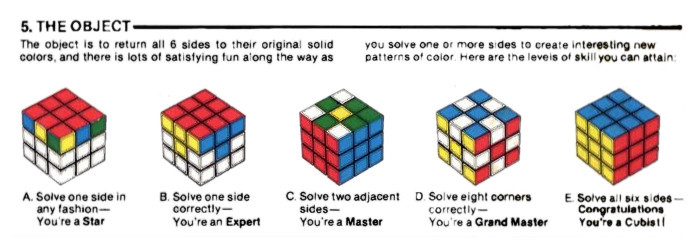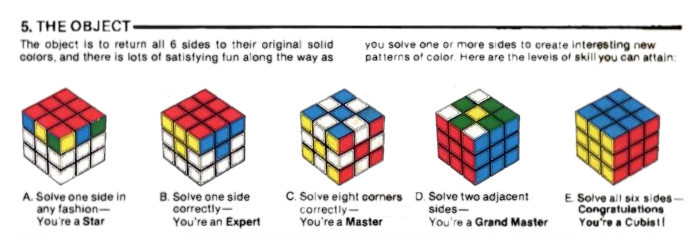After finding a vintage Rubik’s Cube in a charity shop three weeks ago for my neighbor’s son, I’ve been playing with my Rubik’s Cube a little bit more. It really became my fidget toy during the pandemic, and it’s simple enough to pick one up off my desk (at home or at work) and drill myself on, say, an OLL parity. Or teach myself the “edges first” solution from the official Rubik website twenty years ago. I don’t solve the cube to be efficient or fast about it. I practice various moves and try to solve it in interesting ways.
I also went to ebay to see if I could find a cheap used vintage cube. I found several that were tempting… but not tempting enough to actually order. (It’s spring, which means it’s garage sale season, and I’m sure I can procure one for cheap if I wait.)
This lead me to the discovery that Ideal, the company that originally manufactured the Rubik’s Cube forty years ago, published a solution booklet!
I downloaded a scanned PDF of the booklet and worked through it. It’s an interesting solution — you solve (almost!) one side, then you solve the opposite side, you complete the first side, then move the edge pieces around in the middle layer to complete the cube. I don’t know if I’ll learn this solution, but there’s at least one interesting algorithm in it that would be worth knowing.
The really intriguing thing in the booklet was this on the second page:

Five levels of Rubik’s Cube mastery!
And up pipes the critical voice in the back of my head. And another voice that says, “I wonder if this relates, in any way, to Paul McCartney’s ‘There are seven levels’ the first time he got stoned.”
Looking at this, there’s a sense of progression. If you can solve one side, you move on to solving that side with all of the edges correct. (My neighbor’s autistic son has mastered the first — solving the side in any fashion — but not the second — getting the edges of that side correct.) As an aside, the cube displayed for A is impossible; it has two red/green corners with green on the left if red is on top.
Then it moves on to solving two adjacent sides. Note that neither the red side nor the blue side are solved correctly — the edges on the top face are not a single color. Still, there’s a clear implication of progression; if you solve two adjacent sides, you’re a “Master” and on your way to being a Cubist.
As I said six months ago, when my neighbor’s autistic son challenged me to solve two adjacent sides, I was never able to do so when I was young, despite attempting to do so many times. I eventually worked out a two adjacent sides solution, and even though it’s inefficient — you do everything you need to do to solve the cube in the layer-by-layer method, except you don’t solve the cube — I like solving the cube in that way.
Here’s the thing. To solve two adjacent sides, I place and orient the eight corners correctly first. So, to achieve “Master” by this chart from 1981, I have to first be a “Grand Master.”
My solve adjacent sides solution runs:
- Solve one side
- Solve the corners
- Solve the unsolved edge piece of the side from step 2
- Solve the five remaining edge pieces (three on top, two on back)
As an aside, the Speedsolving Wiki calls a “face by face method,” which is what an adjacent sides solution is, “the Fail Method.” I was quite proud of myself for making it work!
So there is a progression from solving a side to solving corners to solving two sides to solving the cube. A more accurate image might look like this:

In any event, nothing in The Ideal Solution will lead a cuber to solving two adjacent sides. The method in the booklet, as I mentioned, solves two opposite sides. The chart, either as published or in my edit, is completely beside the point.
I don’t believe my parents ever had The Ideal Solution, though I wonder if I might have seen it at some point. Perhaps that’s why I was so convinced, as a child, that solving two adjacent sides of a Rubik’s Cube was the right path to solving the whole cube.
But that was so long ago. Who can say?
Whether I’m a master or a grand master for being able to solve two adjacent sides, I don’t feel like a master. I’m a mere padawan learner at the Rubik’s Cube, at best.